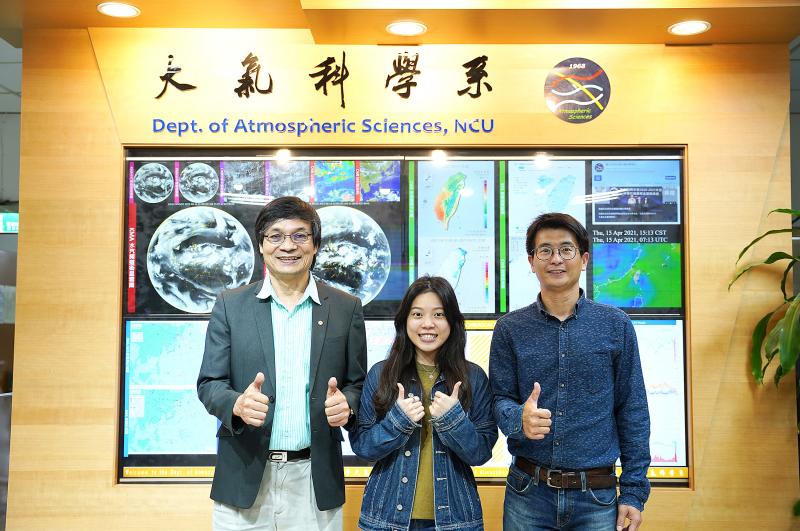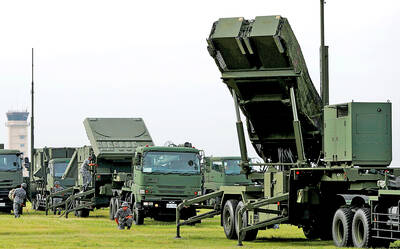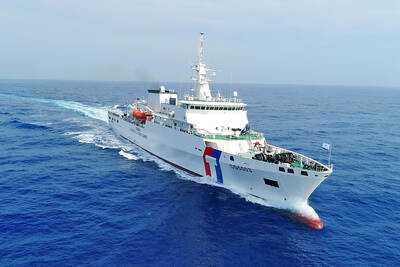New research suggests that air pollution indirectly reduces the amount of rainfall in northern Taiwan during autumn, which might have exacerbated the water shortage at New Taipei City’s Shihmen Reservoir (石門水庫).
Researchers from National Central University (NCU) and the State University of New York at Albany analyzed 13 years of satellite and surface data for the study, which was published on March 23 in the journal Atmospheric Chemistry and Physics.
Taiwan receives most of its annual rainfall from May to September during the plum rain and typhoon seasons, NCU Department of Atmospheric Sciences associate professor Wang Sheng-hsiang (王聖翔) said.

Photo courtesy of National Central University
Although there is relatively less rainfall during fall and winter, it is key to maintaining reservoir levels, Wang said.
However, it is also when pollution tends to be most severe, which not only affects health, but can also affect the characteristics of rain droplets, he added.
Researchers analyzed data from 2005 to 2017 on concentrations of PM2.5 — airborne particulate matter smaller than 2.5 micrometers — meteorological parameters, such as wind direction and temperature, raindrop size, aerosols and cloud properties, to determine the effect that aerosols might have on clouds and drizzle during autumn over northern Taiwan.
They found that in the densely industrialized northwest, the season is mainly dominated by warm, thin and broken clouds, which are defined as having an internal temperature of at least 0°C.
Aerosols were discovered to have an indirect effect on the clouds, meaning that as aerosol concentrations rose, cloud droplets became smaller and more numerous, with drizzles occurring less frequently.
The data also reflected this, as “polluted” days saw about 6.8mm less daily average rainfall than “clean” days, with polluted days defined as the 80th percentile of daily average PM2.5, while clean days fell in the 20th percentile.
Lead author of the study, Chen Ying-chieh (陳映潔), obtained a graduate degree from NCU’s Department of Atmospheric Sciences.
As a graduate student, she was in the first cohort of the US-Taiwan Partnership for International Research and Education (PIRE), which sent her on a two-month exchange to the US.
PIRE is run by the Ministry of Science and Technology and the US National Science Foundation through NCU and the State University of New York at Albany. The program aims to promote research collaboration on weather and climate prediction, and emergency response strategies.

MILITARY BOOST: The procurement was planned after Washington recommended that Taiwan increase its stock of air defense missiles, a defense official said yesterday Taiwan is planning to order an additional four PAC-3 MSE systems and up to 500 missiles in response to an increasing number of missile sites on China’s east coast, a defense official said yesterday. The official, who spoke on condition of anonymity, said that the proposed order would be placed using the defense procurement special budget, adding that about NT$1 trillion (US$32,88 billion) has been allocated for the budget. The proposed acquisition would include launchers, missiles, and a lower tier air and missile defense radar system, they said The procurement was planned after the US military recommended that Taiwan increase

POLITICAL AGENDA: Beijing’s cross-strait Mid-Autumn Festival events are part of a ‘cultural united front’ aimed at promoting unification with Taiwan, academics said Local authorities in China have been inviting Taiwanese to participate in cross-strait Mid-Autumn Festival celebrations centered around ideals of “family and nation,” a move Taiwanese academics said politicizes the holiday to promote the idea of “one family” across the Taiwan Strait. Sources said that China’s Fujian Provincial Government is organizing about 20 cross-strait-themed events in cities including Quanzhou, Nanping, Sanming and Zhangzhou. In Zhangzhou, a festival scheduled for Wednesday is to showcase Minnan-language songs and budaixi (布袋戲) glove puppetry to highlight cultural similarities between Taiwan and the region. Elsewhere, Jiangsu Province is hosting more than 10 similar celebrations in Taizhou, Changzhou, Suzhou,

TWO HEAVYWEIGHTS: Trump and Xi respect each other, are in a unique position to do something great, and they want to do that together, the US envoy to China said The administration of US President Donald Trump has told Chinese President Xi Jinping (習近平) “we don’t want any coercion, but we want [the Taiwan dispute] resolved peacefully,” US ambassador to China David Perdue said in a TV interview on Thursday. Trump “has said very clearly, we are not changing the ‘one China’ policy, we are going to adhere to the Taiwan Relations Act, the three communiques and the ‘six assurances’ that were done under [former US president Ronald] Reagan,” Perdue told Joe Kernen, cohost of CNBC’s Squawk Box. The act, the Three Joint Communiques and the “six assurances” are guidelines for Washington

DEEPENING TIES: The two are boosting cooperation in response to China’s coercive actions and have signed MOUs on search-and-rescue and anti-smuggling efforts Taiwan and Japan are moving to normalize joint coast guard training and considering the inclusion of other allies, the Japanese Yomiuri Shimbun reported yesterday. Both nations’ coast guards in June sent vessels to the seas south of the Sakishima Islands to conduct joint training, the report said, adding that it was the second joint maritime training exercise since the nations severed formal diplomatic ties in September 1972. Japan dispatched the Nagoya Coast Guard’s Mizuho, a 134m, 6,000-tonne patrol vessel which can carry a helicopter, while the Coast Guard Administration (CGA) sent the 126m, 4,000-tonne Yunlin, one of its largest vessels, the report